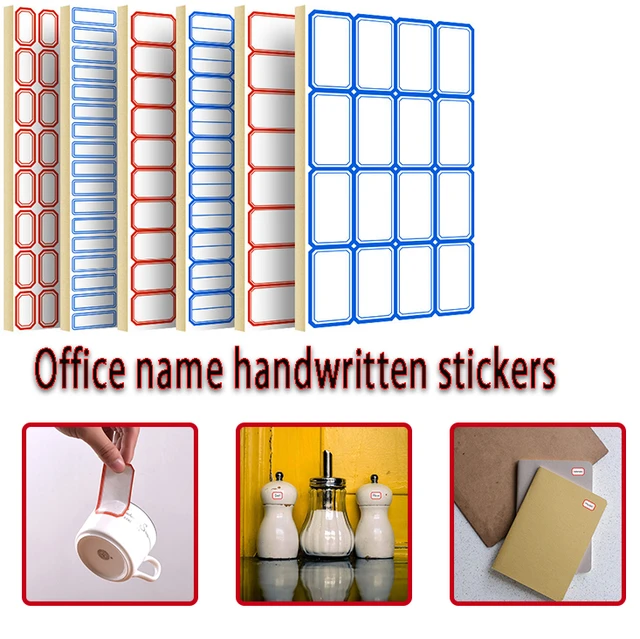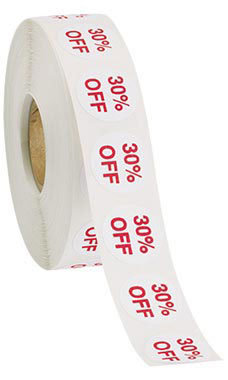Vast Array of Sizes and Shapes for Self-Adhesive Labels
Vast Array of Sizes and Shapes for Self-Adhesive Labels
Blog Article
Picking the Right Self-Adhesive Labels for Your Organization and Personal Needs
Choosing the ideal self-adhesive labels for both organization and personal applications needs a nuanced understanding of different elements that influence their efficiency. Secret considerations consist of the product's resilience, appropriate sizing for ideal presence, and sticky stamina customized to details use situations. Furthermore, the option of coating and printing approaches can dramatically influence visual appeals and functionality. As we discover these essential components, it ends up being clear that a tactical strategy is necessary to guarantee your labels not only fulfill expectations yet additionally boost your total branding and company efforts. What specific obstacles do you deal with in this process?

Recognizing Label Products
When picking self-adhesive tags, comprehending the various tag products is important to guaranteeing optimal performance and toughness. The selection of material straight influences the label's longevity, performance, and look. Usual label materials consist of paper, polyester, polypropylene, and plastic, each offering distinct benefits and drawbacks.

Polyester tags provide premium longevity, being resistant to tearing, moisture, and UV light. This makes them an exceptional selection for commercial applications or products that need long-lasting labeling options (Self-Adhesive Labels). Polypropylene, while comparable to polyester, is normally less costly and offers a great equilibrium of resilience and print high quality
In addition, consider sticky types-- permanent, detachable, or repositionable-- depending upon your particular needs. Eventually, selecting the best label material is important for accomplishing the desired outcome, making sure that your tags carry out efficiently in their designated settings.
Determining the Right Size
Selecting the suitable dimension for self-adhesive tags is a basic action that complements the selection of label products. The dimension of a label can dramatically influence its functionality, exposure, and total impact. For that reason, it is essential to think about the desired use the tag when identifying its measurements.
First of all, evaluate the details that needs to be displayed. Tags containing even more text or graphics will certainly call for larger measurements to make sure readability and aesthetic charm. Conversely, minimalist designs may profit from smaller tags that keep a smooth aesthetic.
Additionally, think about the surface area on which the tag will certainly be applied. Different surface areas, such as boxes, envelopes, or containers, may dictate details size needs to optimize adhesion and presence.
In addition, think regarding the quantity of tags required; bigger tags might be extra cost-effective for bulk printing.
Examining Adhesive Toughness
Exactly how can one guarantee that self-adhesive labels continue to be securely affixed in numerous problems? Assessing glue stamina is important for guaranteeing that labels perform optimally, whether in a regulated environment or topic to extreme temperatures, humidity, or various other elements.
For circumstances, removable adhesives are excellent for tags that may need to be repositioned or gotten rid of without deposit, making them ideal for short-lived applications. On the other hand, permanent adhesives are designed to withstand numerous conditions and supply a solid bond, making them ideal for long-lasting labeling demands.
Testing the sticky strength can entail peel adhesion examinations, which determine the pressure required to remove the label from a additional reading surface area. Inevitably, selecting the appropriate adhesive stamina ensures that self-adhesive labels meet their objective, preserving stability and visibility throughout their desired lifespan.
Picking the Right Complete
The surface of self-adhesive labels plays a considerable duty in their total efficiency and appearance, complementing the glue toughness previously reviewed (Self-Adhesive Labels). The option of surface can impact not only the visual effect of the tag but additionally its durability and performance. Usual finishes consist of matte, gloss, and semi-gloss, each serving various objectives
A matte finish supplies a non-reflective surface area that is excellent for writing, making it ideal for tags that call for hand-written info. This coating likewise often tends to conceal smudges and finger prints, improving the tag's appearance gradually.
On the other hand, a gloss surface supplies a glossy, vibrant appearance that enhances shade saturation, making it excellent for advertising tags that need to stand out. Nonetheless, this surface may be less suitable for creating, as it can smear conveniently.
Semi-gloss coatings strike a balance in between the two, supplying a mild sheen while keeping great writeability. Furthermore, consider elements such as wetness resistance and UV security, especially for labels subjected to severe settings. By meticulously picking the best coating, services and people can guarantee visit here their labels successfully convey their designated message while preserving sturdiness.

Considering Printing Options
Evaluating printing alternatives is crucial for making best use of the performance of self-adhesive labels. The method you select will dramatically influence the quality and toughness of the end product. Self-Adhesive Labels. Usual printing techniques consist of digital, flexographic, and thermal transfer printing, each offering distinctive advantages and factors to consider
Digital printing is optimal for brief runs and variable information, enabling for quick turnaround times and customization. visit this site right here This technique allows companies to produce labels with high-resolution graphics and complex layouts without sustaining significant setup expenses. It may not be the most cost-effective choice for larger quantities.
Flexographic printing, on the other hand, is well-suited for high-volume manufacturing. It utilizes versatile alleviation plates to move ink onto different materials, ensuring consistent quality across big batches. This technique is commonly preferred for its effectiveness and capability to publish on a variety of substratums, including those with unique surfaces.
Thermal transfer printing is one more sensible choice, specifically for labels that need durability versus rough conditions. This approach supplies outstanding print high quality and is commonly made use of for barcode and supply labels.
Ultimately, selecting the right printing option depends upon your specific labeling requirements, budget, and production volume.
Conclusion
In conclusion, choosing the proper self-adhesive tags necessitates cautious factor to consider of different aspects, including label products, dimension, glue toughness, surface, and printing options. Each element plays a crucial function in making certain that the tags meet certain company or individual requirements successfully.
When picking self-adhesive labels, understanding the various tag products is important to ensuring ideal efficiency and longevity.Picking the suitable size for self-adhesive tags is a basic step that matches the choice of tag materials. Eventually, choosing the right sticky strength ensures that self-adhesive labels accomplish their purpose, maintaining integrity and exposure throughout their designated life-span.
The finish of self-adhesive labels plays a substantial role in their total efficiency and look, complementing the adhesive stamina formerly reviewed.In verdict, picking the suitable self-adhesive labels requires careful consideration of numerous elements, consisting of label materials, size, glue strength, coating, and printing alternatives.
Report this page